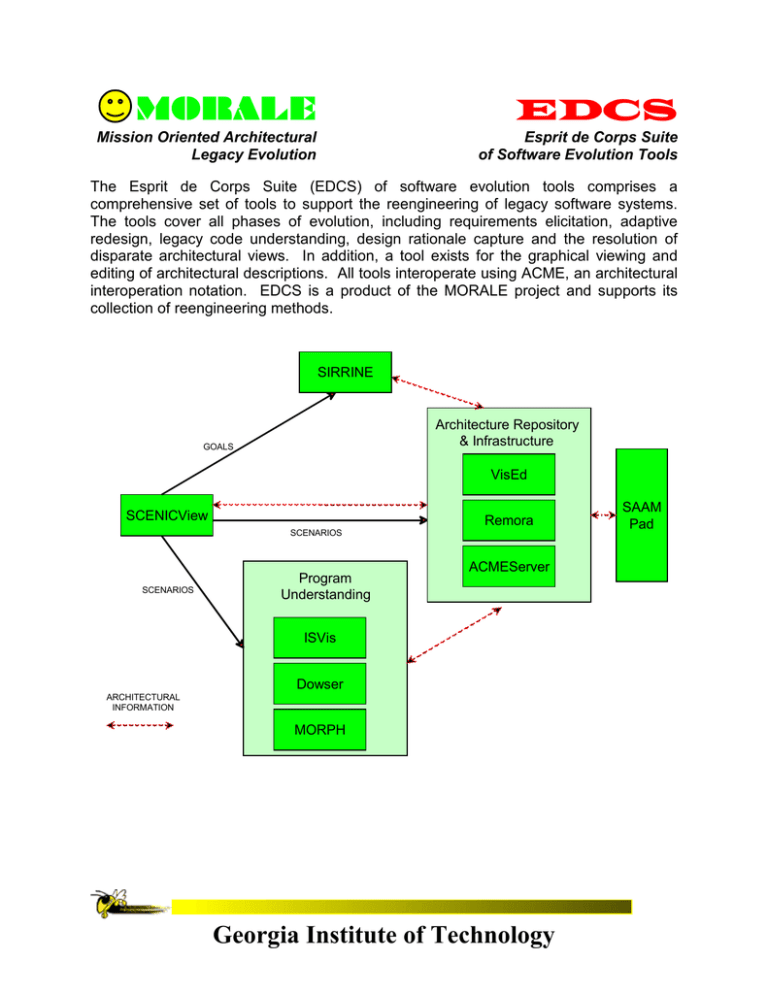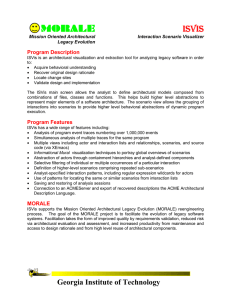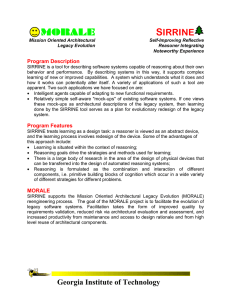MORALE EDCS
advertisement

MORALE EDCS Mission Oriented Architectural Legacy Evolution Esprit de Corps Suite of Software Evolution Tools The Esprit de Corps Suite (EDCS) of software evolution tools comprises a comprehensive set of tools to support the reengineering of legacy software systems. The tools cover all phases of evolution, including requirements elicitation, adaptive redesign, legacy code understanding, design rationale capture and the resolution of disparate architectural views. In addition, a tool exists for the graphical viewing and editing of architectural descriptions. All tools interoperate using ACME, an architectural interoperation notation. EDCS is a product of the MORALE project and supports its collection of reengineering methods. SIRRINE Architecture Repository & Infrastructure GOALS VisEd SCENICView SCENARIOS SCENARIOS Program Understanding Remora ACMEServer ISVis Dowser ARCHITECTURAL INFORMATION MORPH Georgia Institute of Technology SAAM Pad Tool Descriptions • SCENICView: Supports the requirements determination method ScenIC, the Scenario-based Inquiry • • • • • • • • Cycle. ISVis (Interaction Scenario Visualizer): Supports recovery of architectural information through browsing and analysis of execution scenarios SIRRINE (Self Improving Reflective Reasoner Integrating Noteworthy Experience): Performs adaptive redesign of software systems using functional models as architectural descriptions. VisEd (Visual Editor for architectures): Provides an environment for graphically viewing and editing software architectures. ACMEServer: Serves as a communications infrastructure for information exchange using the ACME architectural description language. SAAMPad: Provides automatic capture and access to support the Software Architectural Analysis Method. MORPH (Model Oriented Reengineering Process for HCI): Supports a process for reengineering the user interfaces of character-oriented interactive legacy systems to WIMP-style graphical user interfaces. REMORA (Resolution of MORALE Architectures): Provides automated support for merging various architectural views. Dowser (Domain Oriented Program Browser): Supports access to source code and documentation using application domain vocabulary. MORALE The Mission Oriented Architectural Legacy Evolution (MORALE) project supports evolution of software that is driven by a change in its purpose or mission. The key to the approach is exploiting the synergy between requirements analysis, architecture, and reverse engineering. Effective system evolution requires understanding both the ways that an existing system accomplishes its tasks and the missionoriented rationale for any changes that feed its evolution. The MORALE suite of tools and techniques leverages this synergy by growing a common model of the architecture to serve as a basis for assessing the effects of proposed changes and the extent to which legacy code can be reused. Project Approach MORALE exploits both high level (mission-oriented) requirements and existing software assets in order to predict the extent to which new system requirements perturb an existing system. Requirements are derived from mission-oriented goals and are explored through scenarios, while the existing system is analyzed in terms of its response to high-level event traces (scenario instantiations). The resulting design and scenario information then feeds impact analysis on the architecture. Underlying this suite of tools is a common architectural infrastructure to aid in the exchange of design and scenario information. Contact Information Sponsorship morale-support@cc.gatech.edu http://www.cc.gatech.edu/morale Effort sponsored by the Defense Advanced Research Projects Agency, and the United States Air Force Research Laboratory, Air Force Materiel Command, USAF, under agreement number F30602-96-2-0229. Georgia Institute of Technology


